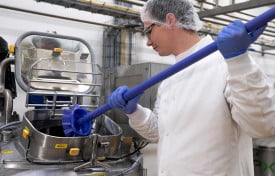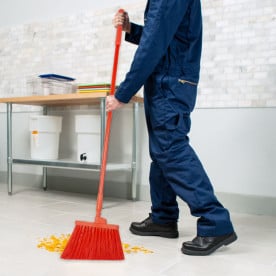Monthly Archives: April 2014

- April 23, 2014
Many pH electrodes are shipped with the electrodes moist. Prior to using your electrode for the first time it needs to be conditioned. While it is always best to refer to the manufacturer instructions for proper electrode conditioning, below are three common recommended steps for conditioning your electrode:
- Remove the protective cap or bottle from the bottom of the sensor and rinse the electrode with distilled or deionized water and blot with a Kimwipe®.
- Place the electrode in a beaker containing one of the liquids listed below (in order of ionic ability to condition the electrode.) Soak for 20 minutes.
3.0 M KCI
4.0 pH buffer
7.0 pH buffer
Note: Never condition or store a pH electrode in water long term exposure to purified water will damage the special glass membrane. - After conditioning the sensor for 20 minutes, rinse the electrode with distilled or deionized water and blot with a Kimwipe. The electrode is now ready for calibration
- April 23, 2014
Discover the world of sanitary gaskets with our comprehensive range of flexible and non-toxic gasket compounds that adhere to stringent FDA specifications. Engineered for direct contact with dairy products and edible oils, these gaskets are also designed to meet the criteria set by 3-A, USDA, and NSF standards. Not only do they exhibit low-swell characteristics, making them well-suited for exposure to oils, steam, and water, but they also won't absorb taste or odors, ensuring the integrity of your products. Our gaskets are available in various materials, including the popular Buna-N, known for its oil resistance, EPDM for steam and hot water service, Viton with exceptional fluid resistance, silicone for outstanding low-temperature flexibility, and Teflon with an impressive temperature range. Each material comes with its unique set of properties, catering to specific application requirements. Shop with confidence, knowing that our gaskets are sold individually, and reach out to our knowledgeable
- April 23, 2014
Prevent premature Washdown hose wear and failure. Washdown hoses are often subjected to physical abuse
while in service. Select a hose that meets or exceeds the application it is intended for.Consider temperature, pressure, and environmental concerns such as abrasion and chemical resistance.
Every plant should have a maintenance/inspection plan in place to ensure the longest possible life of the hose.Be sure to consider these steps in your plan:
- Store hose properly when not in use. Hose racks or reels are highly recommended to keep hoses off the floor
and out of harms way. Pay attention to humidity, temperature, ozone and sunlight. Storing out of direct sunlight,
in a room with moderate humidity and a temperature range of 50° to 75°F is recommended. - Always shut off the water supply to the hose when not in use and open the nozzle to relieve the pressure before storing. Leaving water in the hose subjects it to constant pressure
- Store hose properly when not in use. Hose racks or reels are highly recommended to keep hoses off the floor
- April 22, 2014
Dive into a world of versatility with our extensive gasket line tailored for the unique demands of the food and beverage industries. At your fingertips, you'll find a diverse array of sizes, colors, and materials, meticulously chosen to meet the stringent requirements of these industries. Our commitment to providing comprehensive information is reflected in the Pipeline Gasket Reference Guide, a valuable resource offering insights into material options, temperature ranges, chemical resistance, tear resistance, durometer, and more. Whether you seek gaskets for specific temperature-sensitive applications or those resilient to various chemicals, our reference guide equips you with the knowledge needed to make informed decisions. Explore the possibilities, and discover the perfect gasket solution that aligns with your industry's standards and requirements.
- April 22, 2014
Today is Earth Day 2014. Earth Day was founded by Wisconsin Senator Gaylord Nelson in 1970 as a grassroots demonstration supporting environmental issues. Millions of people participate each year, and it has developed into a day that inspires awareness of and appreciation for the earth’s environment.
Like many of you, Nelson-Jameson has incorporated both sustainable and green practices into our everyday functioning. We feel that it’s the responsible thing to do---not just as a corporate entity, but as a distribution partner in a global supply chain. Our core business model of goods procurement - providing a wide line of products in multiple categories from hundreds of manufacturers - naturally facilitates a reduced logistical footprint through consolidated shipping, receiving and packaging.
Additionally, our manufacturers and customers benefit from the resulting cost-savings advantage that is gained from these distribution standards
- April 15, 2014
We have all heard of “helicopter parents,” those that coddle and hover over their kids. Remarkably annoying to educators, scout leaders, etc., one has to at least respect that they (in their own bothersome and overt way) essentially want to ensure their kid’s safety and well-being. Well, what about being a "helicopter" producer?
Don’t you want to ensure the safety and quality of your product when raw ingredients come into your facility or when the finished product heads out on the truck to be sold? Do you worry that your product might be compromised by influences beyond your control? Are you keeping an eye out for things occurring in-house that might compromise your product?
- April 02, 2014
Now is the time to do annual maintenance on your insect electrocutor units. Late winter is the perfect time to check your insect units to make sure they are working properly, and to do an annual bulb change.
Here are two common questions to remember before spring insect hatchings happen:
My lamps are lit, why do I need to change them?
A lamp that is still lit may not be doing the job you need it to. Black light (UV) lamps are most effective when new. They lose their ability to attract insects long before they actually burn out. UV light is invisible and while the lamps remain lit the UV producing phosphor only has an effective life of 7000 hours or about 9 months.When should I change my bulbs?
It is essential to replace lamps at least annually. Most users choose to change their lamps in the spring, which is the beginning of the insect season. Each lamp comes standard with a year/date label for audit compliance, but also to






